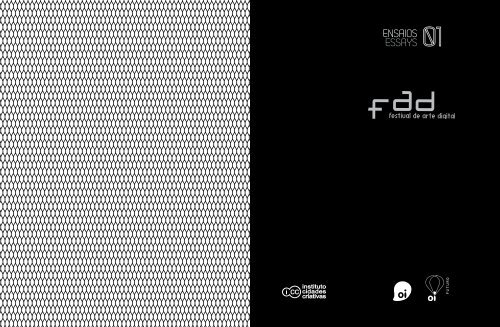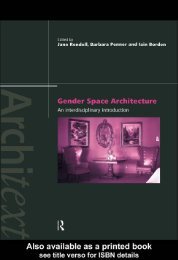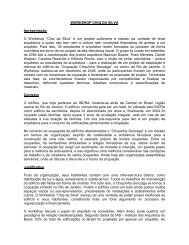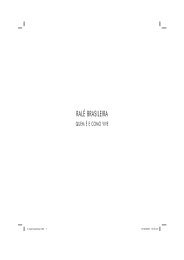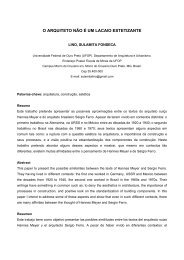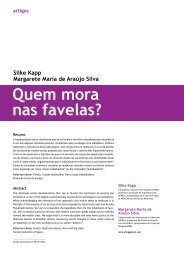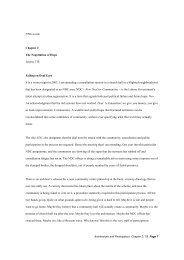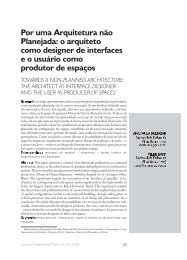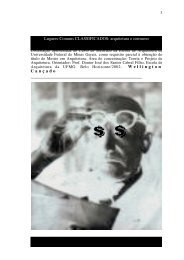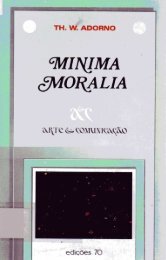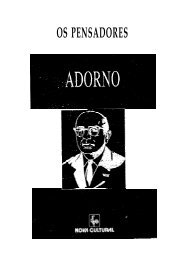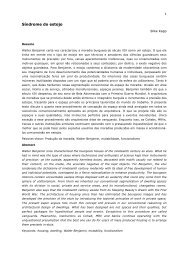Magia além da ignorância: virtualizando a caixa - MOM. Morar de ...
Magia além da ignorância: virtualizando a caixa - MOM. Morar de ...
Magia além da ignorância: virtualizando a caixa - MOM. Morar de ...
You also want an ePaper? Increase the reach of your titles
YUMPU automatically turns print PDFs into web optimized ePapers that Google loves.
00PATRiCIA MORAN45
01o que nos sobrou do universo <strong>da</strong>magia foi a mágica, em seu sentidoatual <strong>de</strong> ilusionismo e entretenimento,que cultivamos como jogo inocente –como um truque que brinca com ouniverso <strong>da</strong>s relações <strong>de</strong> causa e efeito.Com o surgimento <strong>da</strong>s tecnologiasdigitais, a conexão entre mágica etecnologia passa a ser invoca<strong>da</strong> commuita frequência, <strong>de</strong>vido ao fato <strong>de</strong>que a funcionali<strong>da</strong><strong>de</strong> dos aparatosdigitais ca<strong>da</strong> vez mais <strong>de</strong>safia acompreensão do observador comum,tanto pela escala minúscula <strong>de</strong> seuscomponentes quanto por sua capaci<strong>da</strong><strong>de</strong><strong>de</strong> alterar a percepção espaçotemporal.Aceleração e compressãoviraram jargões <strong>de</strong> otimizaçãotecnológica, acenando com a possibili<strong>da</strong><strong>de</strong>fictícia <strong>de</strong> apressar o tempo oudiminuir o espaço, como se <strong>de</strong>tivéssemospo<strong>de</strong>res mágicos bem ao estilo“Harry Potter”. E não é sem razãoque essas tecnologias são chama<strong>da</strong>s<strong>de</strong> “novas tecnologias”, já que <strong>de</strong>safiamtodo o conhecimento <strong>da</strong> jácita<strong>da</strong> relação <strong>de</strong> causa e efeito àqual a técnica tradicional até entãonos havia habituado. Assim, nospostamos diante <strong>de</strong>stas novastecnologias como o homem primitivodiante do mundo pré-científico: frenteaos processos que não compreen<strong>de</strong>mos,recorremos à i<strong>de</strong>ia <strong>de</strong> mágica.Este cenário <strong>de</strong> novas e mágicastecnologias vai impactar também ocampo <strong>da</strong> arte, com o surgimento <strong>da</strong>chama<strong>da</strong> “arte digital”. A relaçãoentre mágica e arte é também antiga,remontando aos exemplos maisarcaicos <strong>da</strong>s pinturas parietais <strong>de</strong>cavernas pré-históricas. Há clarasevidências <strong>de</strong> que estas eram liga<strong>da</strong>sa rituais, certamente <strong>de</strong> magia. Dequalquer forma a arte, <strong>de</strong>s<strong>de</strong> suasorigens mais remotas, tem comocaracterística o processo <strong>de</strong> invençãoe criação que, <strong>de</strong> alguma maneira,mimetiza um processo criativo divino– neste sentido ver<strong>da</strong><strong>de</strong>iramentemágico, capaz <strong>de</strong> criar um mundo apartir do na<strong>da</strong>.Sob essa ótica, a arte digital seriaduplamente mágica: por ser arte e,portanto, invenção do inexistente, epor ter como suporte uma técnica <strong>de</strong>aspectos mágicos (truque). No entanto,quando observamos a maioria dosexemplos <strong>de</strong> artes digitais, elas estãomenos liga<strong>da</strong>s à magia no sentidoarcaico (a magia <strong>da</strong> experiência) emais à mágica como recreação,basea<strong>da</strong>s no ilusionismo <strong>de</strong>corrente<strong>da</strong> ignorância do que é programado.Mas sabemos que não há mágica nomundo do programa, apenas umacerta opaci<strong>da</strong><strong>de</strong> <strong>de</strong> seu funcionamento.A ignorância do processo programático,“tecnológico”, po<strong>de</strong> parecermágica no sentido do truque, mas amagia que nos interessa resi<strong>de</strong> nafruição, na experiência do espectador.Um exemplo interessante <strong>de</strong> como otruque é irrelevante na elaboraçãoartística são os quadros <strong>de</strong> Vermeer,que até recentemente foram consi<strong>de</strong>radoscomo uma aplicação <strong>da</strong>stécnicas <strong>de</strong> perspectiva, o que seriabem típico <strong>de</strong> sua época. No entanto,Steadman <strong>de</strong>monstrou que o processoadotado teria sido na ver<strong>da</strong><strong>de</strong> acâmera escura, o que alguns críticos,indignados, veem como um truque.Mas, na ver<strong>da</strong><strong>de</strong>, não faz diferençapara a experiência artística o processousado por Vermeer. O que interessa éa <strong>de</strong>lica<strong>de</strong>za <strong>da</strong>s cenas cria<strong>da</strong>s pelasmulheres retrata<strong>da</strong>s em seus afazeresdo cotidiano, ou seja, a magia <strong>da</strong>experiência e não a mágica do truque.Uma forma <strong>de</strong> li<strong>da</strong>r com a ignorânciados processos sem recorrer à i<strong>de</strong>ia <strong>de</strong>mágica e sem recorrer ao processo <strong>de</strong><strong>de</strong>smistificação (retira<strong>da</strong> do mistério)<strong>da</strong> técnica surgiu mais recentementecom a adoção do conceito <strong>de</strong> <strong>caixa</strong>pretapela Cibernética. Esse conceito,<strong>de</strong>senvolvido por Ashby, propõe quetratemos metaforicamente como<strong>caixa</strong>-preta os fenômenos dos quais<strong>de</strong>sconhecemos o mecanismo <strong>de</strong>funcionamento e que apenas sabemoso input e o output resultante. Éimportante salientar que a <strong>caixa</strong>-pretaé um constructo conceitual e não umobjeto físico. A <strong>de</strong>speito disso, muitosartistas tomam a i<strong>de</strong>ia literalmente eacabam criando <strong>caixa</strong>s físicas, que,ain<strong>da</strong> que apresentem algum mecanismo<strong>de</strong> interação, seduzem oespectador pela ignorância dosmecanismos operativos e não pelamagia <strong>da</strong> experiência.Se quisermos <strong>de</strong>senvolver <strong>caixa</strong>s-pretasver<strong>da</strong><strong>de</strong>iramente interativas, quepropiciem a magia <strong>da</strong> experiência (enão a magia pela ignorância dosprocessos), <strong>de</strong>veremos recorrer aovirtual que não é o meramente digital.No lugar do “branqueamento” <strong>da</strong><strong>caixa</strong>-preta (que torna a experiênciaprevisível e pre<strong>de</strong>termina<strong>da</strong>, pois otruque é revelado ao espectador ouusuário, que per<strong>de</strong>, assim, o interessena interação), propomos a discussão<strong>de</strong> processos que não sejam<strong>caixa</strong>s (nem pretas nem brancas),mas interfaces virtuais, eventos-latentes,com os quais as pessoas possamse engajar e <strong>da</strong>r continui<strong>da</strong><strong>de</strong> nos<strong>de</strong>signs. Essa seria a virtualização <strong>da</strong><strong>caixa</strong>-preta, partindo <strong>da</strong> abertura do<strong>de</strong>sign aos outros – um <strong>de</strong>sign responsável,como trabalhado por Flusser.Para Flusser, todo objeto <strong>de</strong> <strong>de</strong>signtem por intuito remover um obstáculo(um problema), e, para isso, cria umnovo obstáculo (objeto). A questãoque se coloca é sobre como ser omenos obstacularizante possível,abrindo o <strong>de</strong>sign para o Outro.Enten<strong>de</strong>mos que o virtual aju<strong>da</strong> acaminhar nessa direção.O virtual não é sinônimo <strong>de</strong> digital eo digital geralmente não é virtual.Digital é uma tecnologia distinta <strong>da</strong>analógica, basea<strong>da</strong> em inputs <strong>de</strong> 0 e1, que po<strong>de</strong> oferecer uma gama quaseinfinita <strong>de</strong> combinações para interação.Contudo, o fato <strong>de</strong> oferecer possibili<strong>da</strong><strong>de</strong>stécnicas para interação nãosignifica ser virtual. Por outro lado, ostrabalhos <strong>de</strong> Lygia Clark, por exemplo,oferecem interação analógica epo<strong>de</strong>m ser consi<strong>de</strong>rados virtuais. Tantointerativi<strong>da</strong><strong>de</strong> digital quanto analógicapo<strong>de</strong>m ser classifica<strong>da</strong>s segundo suavirtuali<strong>da</strong><strong>de</strong>, numa escala que varia<strong>de</strong> interativi<strong>da</strong><strong>de</strong> “não-interativa” ainterativi<strong>da</strong><strong>de</strong> “interativa”. Nessaescala, uma <strong>caixa</strong> <strong>de</strong> música, porexemplo, estaria próxima <strong>da</strong> interativi<strong>da</strong><strong>de</strong>“não-interativa”, pois a interaçãose dá com a interface e não como conteúdo. Acionamos a manivela(interface) e a música toca<strong>da</strong> (conteúdo)está totalmente pre<strong>de</strong>termina<strong>da</strong>.Já o piano, por exemplo, encontra-sedo outro lado <strong>da</strong> escala, próximo <strong>da</strong>interativi<strong>da</strong><strong>de</strong> “interativa”, poisinteragimos com o conteúdo através<strong>da</strong> interface: a música não estáprete<strong>de</strong>rmina<strong>da</strong>, é cria<strong>da</strong> a partir <strong>da</strong>interação com as teclas. Certamente,uma interface nunca é neutra, já queseu grau <strong>de</strong> prescrição afeta a escalaAna Paula Baltazar e José dos Santos Cabral Filho - <strong>Magia</strong> além <strong>da</strong> Ignorância: Virtualizando a Caixa-Preta.14 15
Ambiente virtual <strong>de</strong>imersão produzidopelo LAGEARusando a espacialização<strong>de</strong> imagensinterativas por meio<strong>de</strong> gestos<strong>de</strong> interativi<strong>da</strong><strong>de</strong>, como <strong>de</strong>monstramos exemplos acima.O virtual, que preserva a mágica <strong>da</strong>experiência por engajar o usuário nacriação <strong>de</strong> situações, sempre operacom a possibili<strong>da</strong><strong>de</strong> <strong>de</strong> interação nãoprescrita (interativi<strong>da</strong><strong>de</strong> “interativa”).A Máscara com Espelhos (1967) <strong>de</strong>Lygia Clark, por exemplo, celebraessa interativi<strong>da</strong><strong>de</strong> colocando pequenosespelhos manipuláveis em frentedos olhos do usuário, fragmentando esobrepondo imagens do entorno às dopróprio usuário. A artista não disponibilizaum produto pronto e acabado aser usado, mas uma interfaceanalógica que induz e canalizaexperiências únicas. Esse trabalho sóganha existência efetiva temporariamente,quando <strong>da</strong> interação dousuário. No extremo oposto estaria achama<strong>da</strong> reali<strong>da</strong><strong>de</strong> virtual <strong>de</strong> imersão,em que o espectador experimentauma simulação, uma reproduçãoprescrita a priori, que é sempre digital,mas dificilmente virtual.O virtual caracteriza-se, assim, comoum evento latente, ain<strong>da</strong> não manifesto,e embora seja atualizável pelainteração <strong>da</strong>s pessoas com umainterface, tal interação não é prescritana interface. Recorrendo a Hei<strong>de</strong>gger,po<strong>de</strong>mos dizer que o virtual difere<strong>de</strong> uma pedra que está “presente àmão”, e, embora tenha proprie<strong>da</strong><strong>de</strong>s,não tem atributos; difere, ain<strong>da</strong>, <strong>de</strong>um martelo, que está “pronto àmão”, com proprie<strong>da</strong><strong>de</strong>s e atributospreviamente <strong>de</strong>finidos. O virtualextrapola essas categorias <strong>de</strong> Hei<strong>de</strong>ggere aponta para o que po<strong>de</strong>moschamar <strong>de</strong> “aberto à mão”, cujosatributos são temporariamente<strong>de</strong>finidos pelos usuários durante ainteração. Embora as proprie<strong>da</strong><strong>de</strong>s <strong>de</strong>uma interface (sua substância potencialou real, para usar os termos <strong>de</strong>Lévy) sempre limitem suas possibili<strong>da</strong><strong>de</strong>s<strong>de</strong> atualização, para que seja<strong>de</strong> fato virtual, esse limite <strong>de</strong>ve ser omenor possível, <strong>da</strong>ndo priori<strong>da</strong><strong>de</strong> aoevento, à experiência não prescrita naelaboração <strong>da</strong> interface.Todo <strong>de</strong>sign leva o evento emconsi<strong>de</strong>ração, ain<strong>da</strong> que na maioria<strong>da</strong>s vezes busque apenas antecipare cristalizar as possibili<strong>da</strong><strong>de</strong>s <strong>de</strong>uso ou fruição. Um objeto ou interfacevirtual, ao contrário, consi<strong>de</strong>ra oevento em seu estado latente e nãoprescritivo. A Máscara com Espelhos,por exemplo, não tem atributosprévios ao seu uso. Obviamente,a artista não criou uma interfaceneutra, totalmente <strong>de</strong>sprovi<strong>da</strong> <strong>de</strong>intenção. Contudo, a intenção <strong>da</strong>artista, ou atributo prévio, não dizrespeito à prescrição do evento,mas à abertura <strong>de</strong> novas possibili<strong>da</strong><strong>de</strong>s<strong>de</strong> percepção <strong>de</strong> seus usuários,configurando-se assim como umevento-latente (virtual e atualizável),e não como um objeto meramentebaseado na substância (potencialou real).Assim, a consi<strong>de</strong>ração do evento emseu estado latente, ou seja, semprescrever os atributos que resultarão<strong>da</strong> interação <strong>da</strong>s pessoas, é fun<strong>da</strong>mentalpara a elaboração <strong>de</strong> interfacesvirtuais. Isso, contudo, não temsido o foco do <strong>de</strong>senvolvimento <strong>da</strong>arte digital em geral, que, apesar <strong>de</strong>resultar em inúmeros produtos parainteração do usuário, acaba prescrevendotal interação. Isso acontecetanto nos objetos e imagens digitaisque respon<strong>de</strong>m <strong>de</strong> forma pre<strong>de</strong>termina<strong>da</strong>à interação dos usuários, quantonas artes generativas, em que ousuário <strong>de</strong>senca<strong>de</strong>ia um processopré-programado, do qual não temconsciência nem controle, gerandoum produto que, ain<strong>da</strong> que dinâmico,não é virtual por não propiciar umaexperiência mágica, apenas o fascínio<strong>de</strong>vido à ignorância do processo. Emsuma, uma <strong>da</strong>s formas <strong>de</strong> usufruir doque há <strong>de</strong> melhor <strong>da</strong> mágica, que é amagia <strong>da</strong> experiência, seria a virtualização<strong>da</strong> <strong>caixa</strong>-preta, ou seja, suatransformação em uma ver<strong>da</strong><strong>de</strong>irainterface aberta ao Outro.ReferênciasBibliográficas:Baltazar dos Santos, A. P. (2007).Towards a virtual architecture: themobility of essences and the ‘open inhand’ in the production-consumptionof spaces, Proceedings of theInternational Conference Architectureand Phenomenology. Israel: Haifa.Flusser, V. (1999). Design: obstaclefor/to the removal of obstacles. in:Flusser, V. (Ed.), The shape of things:a philosophy of <strong>de</strong>sign. London:Reaktion. pp. 58–61.NotaEstas discussõestêm informado aspesquisas etrabalhos que temoselaborado noLAGEAR (LaboratórioGráfico paraExperimentaçãoArquitetônica /UFMG):www.arq.ufmg.br/lagearAna Paula Baltazar e José dos Santos Cabral Filho - <strong>Magia</strong> além <strong>da</strong> Ignorância: Virtualizando a Caixa-Preta.16 17
01Glanville, R. (s.d.), “Second or<strong>de</strong>rcybernetics”, .Hei<strong>de</strong>gger, M. (1995). Being andtime. Oxford: Blackwell.Leakey, R. (1994). The origin ofhumankind. London: Wedienfeld &Nicolson.Lévy, P. (1996). O que é o virtual? SãoPaulo: Ed. 34.Osthoff, S. (1997). “Lygia Clark andHélio Oiticica: a legacy of interactivityand participation for a telematicfuture”. In: Leonardo: journal for theinternational society for the arts,sciences and technology. Cambridge:MIT Press. Vol. 30, No. 4, August, pp.279–89. .Steadman, P. (2002). Vermeer’scamera: uncovering the truth behindthe masterpieces. Oxford: OxfordUniversity Press.Thomas, K. (1971). Religion and the<strong>de</strong>cline of magic: studies in popularbeliefs in sixteenth and seventeenthcentury England. London: Penguin.Ana Paula Baltazar andJosé dos SantosCabral FilhoMagic beyondignorance:virtualizingthe black box.Magic has been present inhuman history for a long timeand we <strong>de</strong>veloped the habit ofseeing magical explanations asa result of ignorance: unable toexplain the natural phenomenonthe primitive men used magicalexplanations, what we callsupernatural explanations, inor<strong>de</strong>r to indicate its nonscientificcharacter. Contrary tothe supernatural magicalexplanation, there is the realmof technique that <strong>de</strong>als with thenatural phenomenon in arational way. Magic would workwith enchantment based onfigurative expressions whoserelationships of cause and effectof the processes are done byequivalence to appearance. Onthe other hand, technique wouldsearch for a disenchantment ofthe appearances, regarding theprocesses of cause and effectbased on mechanical andmathematical principles.This opposition between magic andtechnique is in fact more complex thanit seems and we can say that both havesimilar goals: they try to un<strong>de</strong>rstandthe interrelationships among thenatural phenomena and also interferewith these ongoing processes; they tryto make life possible in a meaninglessand inhospitable nature where magicsearches for the meaning of theexperience and technique searchesfor the solution of practical problems(experience ma<strong>de</strong> functional). In short,both are ways of <strong>de</strong>aling with ourignorance of the world. With thetechnological <strong>de</strong>velopment and theconsequent disenchantment of theworld, what remained of the realm ofmagic was its current sense ofillusionism and entertainment that wecultivate as an innocent game; as atrick that plays with the realm ofcause and effect relationships.With the emergence of digitaltechnologies, the link between magicand technology is frequently claimeddue to the fact that the functionalcharacter of digital apparatus challengesthe un<strong>de</strong>rstanding of ordinary observerseither because of their tiny componentsor because of their power to changethe space-time perception. Accelerationand compression turned to be jargonsof technological optimization, temptingus with the false possibility ofaccelerating time or diminishing space,as if we had the same magical powersof a Harry Potter. Not unreasonablyare those technologies called “newtechnologies”, for they <strong>de</strong>fy ourknowledge of space and time as wewere used to by traditional technique.So, we position ourselves in the faceof these technologies just like theprimitive men were in the face ofpre-scientific world: when confrontedwith processes that we do notun<strong>de</strong>rstand, we turn to the i<strong>de</strong>a ofmagic.Ana Paula Baltazar e José dos Santos Cabral Filho - <strong>Magia</strong> além <strong>da</strong> Ignorância: Virtualizando a Caixa-Preta.18 19
01This scenario of new and magicaltechnologies will also influence thearts with what we call “digital art”.The relationship between art andmagic is an old one coming from theancient examples of Parietal paintingson prehistoric caves. There are clearevi<strong>de</strong>nces that they were connectedto rituals, most probably magicalones. Anyway, art since its remoteorigins features the invention and thecreation process that in a way reflectsa divine creative process, trulymagical in this sense, capable ofcreating a world out of nothing.Seen through this viewpoint digitalart would be magical in double: firstbecause it is art, thus being theinvention of the non-existent;secondly because it is supported by atechnique that has magical aspects(tricks). Nevertheless, when weobserve the majority of digital artexamples they are less connected tomagic in the old sense (the magic ofexperience) and more to magic as aplayful thing, based on illusionismwhich is a result of the ignorance ofwhat has been programmed. But weknow that there is no magic in theworld of programming, only a certainblur related to the way it works. Theignorance about this programmingprocess, so called “technological”,may seem as magic in the sense oftrick, but the magic that interests usis in the enjoyment, in the experienceof the viewer.The paintings of Vermeer are aninteresting example of how trick isirrelevant to artistic creation. Untilvery recently they were consi<strong>de</strong>red asthe application of perspectivetechniques, something typical of thetime. However, Steadman has shownthat the process used was in fact the<strong>da</strong>rk camera, which some critics sawwith indignation as a trick. In fact,the process that Vermeer used doesnot make any difference to the artisticexperience. What counts is the<strong>de</strong>licacy of the scenes created by thewomen <strong>de</strong>pictured in their every<strong>da</strong>ychores, that is, the magic of theexperience, not the magic of the trick.A way of <strong>de</strong>aling with the ignoranceof the processes without referring tothe i<strong>de</strong>a of magic or to the process of<strong>de</strong>mystification of the technique(withdrawal of the mystery), hasrecently appeared with the concept ofblack box by Cybernetics. This concept,which was <strong>de</strong>veloped by Ashby,proposes a metaphorical treatment ofthe phenomena whose workingmechanisms are unknown to us, andof which we only know the resultinginput and output, as a black box. It isimportant to highlight that the blackbox is a conceptual construct and nota physical object. In spite of this, lotsof artists take the i<strong>de</strong>a literally an<strong>de</strong>nd up creating physical boxes that,although they have a kind of interactionmechanism, seduce the viewer by theignorance of the way the mechanismoperates and not because of themagic of the experience.If we want to <strong>de</strong>velop really interactiveblack boxes that create the magic ofexperience (and not the magic of theignorance of the processes) we mustrefer to the virtual that is not merelydigital. Instead of “whitening” theblack box (which makes experiencepredictable and pre<strong>de</strong>termined, forthe trick is revealed to the viewer oruser who lose interest in theinteraction), we propose thediscussion of the processes that arenot boxes (neither black nor white),but virtual interfaces, latent-events,with which people could engage andcontinue the <strong>de</strong>signs. This would bethe black box ma<strong>de</strong> virtual, <strong>de</strong>partingfrom opening the <strong>de</strong>sign to others, aresponsible <strong>de</strong>sign, as the one<strong>de</strong>veloped by Flusser.To Flusser every <strong>de</strong>sign object ismeant to remove an obstacle (aproblem), and in or<strong>de</strong>r to do thiscreates another obstacle (object).The issue that imposes itself is howto be as less hin<strong>de</strong>ring as possible,opening the <strong>de</strong>sign for the other.We think that the virtual helps goingin this direction.Generally speaking, the virtual is nota synonym for digital and the digitalis not virtual. Digital is a technologydifferent from the analog, based oninputs of 0 and 1 that could offeralmost infinite types of combinationfor interaction. However, the fact thatit provi<strong>de</strong>s technical possibilities forinteraction does not mean it is virtual.On the other hand, the works by LygiaClark, for example, offer analoginteraction and can be consi<strong>de</strong>redvirtual. Both digital and analoginteraction can be ranked accordingto its virtuality in a scale that goesfrom “non-interactive” interactivity to“interactive” interactivity. Accordingto this scale, a music box, for example,would be close to non-interactiveinteractivity because the interactionis with the interface not the content.We wind the crank (interface) and themusic that plays (content) is completelypre<strong>de</strong>termined. The piano, forexample, is on the other si<strong>de</strong> of thescale, close to the “interactiveinteractivity”, for we interact with thecontent through the interface: themusic is not pre<strong>de</strong>termined but iscreated from the interaction with thekeys. Obviously, an interface is neverneutral, since its level of prescriptionaffects the interactivity scale, as theexamples above <strong>de</strong>monstrate.The virtual, that preserves the magicof the experience by engaging theuser in the creation of new situations,always operates with the possibilityof non-prescribed interaction(“interactive” interactivity). TheMask with Mirrors (Máscara comEspelhos) by Lygia Clark (1967), forexample, promotes this interactivityby placing small mirrors that couldbe manipulated in front of the eyesof the viewer, breaking images intofragments and superimposing theseimages of the surroundings on theones of the viewer himself. Theartist does not provi<strong>de</strong> a finishedproduct, ready to be used, but ananalog interface that leads to uniqueexperiences. This kind of artworkonly exists temporarily, wheninteracting with the user. On theopposite si<strong>de</strong> would be the so calledvirtual reality of immersion, wherethe viewer experiences a simulation,a prescribed reproduction that isalways digital but not often virtual.Therefore, the virtual is a latentevent, not already manifested, andthough it could be up<strong>da</strong>ted by theinteraction of the people with aninterface, this interaction is notprescribed in the interface. Referringto Hei<strong>de</strong>gger, we could say that thevirtual differs from a stone becauseit is close to the hand, and althoughAna Paula Baltazar and José dos Santos Cabral Filho - Magic Beyond Ignorance: Virtualizing the Black Box.20 21
01it has special qualities it does nothave attributes, and it is also differentfrom a hammer that is ready to usewith special qualities and attributesthat have already been <strong>de</strong>fined. Thevirtual goes beyond these Hei<strong>de</strong>ggercategories and points to somethingthat we could call “open to the hand”whose attributes are temporarily<strong>de</strong>fined by users during the interaction.Although the special qualities of aninterface (its potential or real essence,using Lévy’s terminology) always putlimits to their possibilities of up<strong>da</strong>ting,these limits should be as small aspossible to be consi<strong>de</strong>red reallyvirtual, prioritizing the event, thenon-prescribed experience in themaking of the interface.Every <strong>de</strong>sign takes the event intoconsi<strong>de</strong>ration, even though itfrequently tries only to anticipate andsettle the possibilities of use orenjoyment. On the contrary, an objector virtual interface consi<strong>de</strong>rs theevent in its latent and non-prescriptivestate. The Mask with Mirrors, forexample, does not have prior attributesto its use. Obviously, the artist hasnot created a neutral interface, totally<strong>de</strong>void of intention. Yet, the artist’sintention, or prior attribute, does notrefer to the prescription of the event,but to the opening to new possibilitiesof perspectives from its users, sobeing a latent-event (virtual and dueto up<strong>da</strong>ting) and not a simple objectbased on essence (potential or real).So, to consi<strong>de</strong>r the event in its latentstate, that is, without prescribing theattributes that will be the results ofpeople interaction, is paramount tothe making of virtual interfaces.However, this has not been the focusof the <strong>de</strong>velopment of digital art ingeneral, for although it results in agreat number of products to theinteraction of the user, it ends upprescribing this interaction. Thishappens on both objects and digitalimages that responds in apre<strong>de</strong>termined way to the userinteraction, and in the generativearts, where the user starts a preprogrammedprocess of which hehas neither conscience nor control,engen<strong>de</strong>ring a product which, thoughdynamic, is not virtual, for it doesnot favor a magical experience, butonly a kind of fascination owing tothe ignorance of the process. Inshort, one of the ways of enjoyingthe best of magic which is the magicof the experience would be thevirtualization of the magic box, thatis, the changing of it into a trueinterface open to the Other.Selected Bibliography:Baltazar dos Santos, A. P. (2007).Towards a virtual architecture: themobility of essences and the ‘open inhand’ in the production-consumptionof spaces, Proceedings of theInternational Conference Architectureand Phenomenology. Israel: Haifa.Flusser, V. (1999). Design: obstaclefor/to the removal of obstacles. in:Flusser, V. (Ed.), The shape of things:a philosophy of <strong>de</strong>sign. London:Reaktion. pp. 58–61.Glanville, R. (s.d.), “Second or<strong>de</strong>rcybernetics”, .Hei<strong>de</strong>gger, M. (1995). Being andtime. Oxford: Blackwell.Leakey, R. (1994). The origin ofhumankind. London: Wedienfeld &Nicolson.Lévy, P. (1996). O que é o virtual? SãoPaulo: Ed. 34.Osthoff, S. (1997). “Lygia Clark andHélio Oiticica: a legacy of interactivityand participation for a telematicfuture”. In: Leonardo: journal for theinternational society for the arts,sciences and technology. Cambridge:MIT Press. Vol. 30, No. 4, August, pp.279–89. .Steadman, P. (2002). Vermeer’scamera: uncovering the truth behindthe masterpieces. Oxford: OxfordUniversity Press.Thomas, K. (1971). Religion and the<strong>de</strong>cline of magic: studies in popularbeliefs in sixteenth and seventeenthcentury England. London: Penguin.Ana Paula Baltazar and José dos Santos Cabral Filho - Magic Beyond Ignorance: Virtualizing the Black Box.22 23
BIOSAna Paula Baltazar é arquiteta,doutora em arquitetura e ambientesvirtuais pela University CollegeLondon e professora <strong>da</strong> Escola <strong>de</strong>Arquitetura <strong>da</strong> UFMG. Desenvolvepesquisas junto ao LAGEAR e <strong>MOM</strong>em interfaces físicas, digitais ehíbri<strong>da</strong>s, e em ambientes <strong>de</strong> imersãoestereoscópicos. Seu interesse maisrecente está na execução Museu-Tempo, conectando espaços-eventosem tempo real.Ana Paula Baltazar is an architect,with a doctorate <strong>de</strong>gree on architectureand virtual environments at theUniversity College London, andprofessor at UFMG ArchitectureSchool. Together with LAGEAR and<strong>MOM</strong>, she <strong>de</strong>velops a research programon physical, digital and hybridinterfaces, and on stereoscopicimmersion environments. Her latestinterest is in implementing theMuseu-Tempo project, which connectsplaces and events in real timeJosé Cabral Filho é graduado emArquitetura e Urbanismo pela UFMG.Mestre em Architectural Studies -University of Sheffield e doutor emArchitectural Studies - University ofSheffield com pós-doutorado pelaMcGill University (Montreal). Professor<strong>da</strong> UFMG, Cabral é membro docorpo editorial <strong>de</strong> Chora: Intervals inthe Philosophy of Architecture. Atua,principalmente, com arquitetura enovas tecnologias.José Cabral Filho has a graduation<strong>de</strong>gree on Architecture and Urbanismat UFMG. He is a master and doctoron Architectural Studies (Universityof Sheffield), with a postdoctoral<strong>de</strong>gree at the McGill University(Montreal). Professor at UFMG, he isalso a member of the editorial boardof Chora: Intervals in the Philosophyof Architecture. He works mainly withnew technologies and architecture.Eduardo <strong>de</strong> Jesus é graduadoem Comunicação Social pela PUC <strong>de</strong>Minas Gerais. Em 2003, foi aprovadopara uma bolsa <strong>de</strong> pós-graduaçãoem curadoria e arte contemporâneapelo MECAD, em Barcelona on<strong>de</strong>realizou a pesquisa: “Desenvolvimento<strong>de</strong> arte e mídia na África, Ásia eAmérica Latina”. Eduardo é Mestreem Comunicação Social pela UFMG edoutor Artes Visuais pela USP.Eduardo <strong>de</strong> Jesus has a graduation<strong>de</strong>gree on Social Communicationat PUC Minas. Selected for a curatingand contemporary art post-graduationscholarship at MECAD (Barcelona) in2003, where he <strong>de</strong>veloped theresearch “Desenvolvimento <strong>de</strong> arte emídia na África, Ásia e AméricaLatina” [Development of media art inAfrica, Asia and Latin America]. He isa master on Social Communication atUFMG, and a doctor on Visual Arts atUSP.01124 125
01Sandro Canavezzi é graduado naEscola <strong>de</strong> Arquitetura e Urbanismo<strong>da</strong> EESC-USP. Mestre em Artes pelaUniversi<strong>da</strong><strong>de</strong> <strong>de</strong> São Paulo (2000).Fez especialização em GenerativeSystems (T.I.) no Co<strong>de</strong>lab_Berlim, naAlemanha, <strong>de</strong> 2001 a 2003. Em2004, foi artista resi<strong>de</strong>nte no V2_Org, em Roterdã. Tem experiência naárea <strong>de</strong> Artes, com ênfase em arteeletrônica interativa.Sandro Canavezzi graduated atthe Architecture and UrbanismSchool, ECC/USP. He has a master<strong>de</strong>gree on Arts at USP (2000). He isspecialized in Generative Systems(T.I.) at Co<strong>de</strong>lab_Berlim, Germany(2001-2003). He was a resi<strong>de</strong>ntartist at V2_ Org, in Rotter<strong>da</strong>m(2004). He has experience on arts,with emphasis on interactiveelectronic art.Patricia Moran é Mestre emComunicação Social pela UFRJ edoutora em Comunicação e Semióticapela PUC - São Paulo. Diretora <strong>de</strong>diversos curtas-metragem já foiagracia<strong>da</strong> com prêmios no Brasil e noexterior. Acaba <strong>de</strong> estrear seuprimeiro longa-metragem Ponto Org.Desenvolve pesquisa acadêmicasobre projeções audiovisuais intitula<strong>da</strong>:A metáfora dos sentidos. Professorado Curso Superior do Audiovisualna ECA-USP.Patricia Moran is a master inSocial Communication at UFMG, andholds a doctorate <strong>de</strong>gree inCommunication and Semiotics atPUC/SP. She is a director of severalshort films, and she has been awar<strong>de</strong>dprizes in Brazil and abroad. She hasjust premiered his first feature film,Ponto Org. She <strong>de</strong>velops an aca<strong>de</strong>micresearch on audiovisual projections,called “A metáfora dos sentidos”[The senses metaphor]. She is aprofessor in the audiovisual course atECA/USP.Sonia Labouriau é artista,performer, vi<strong>de</strong>omaker, curadora e<strong>de</strong>signer. Dedica-se também àpesquisa e ao ensino. Além <strong>de</strong> atuarno circuito <strong>da</strong> arte e interfaces comoutras ativi<strong>da</strong><strong>de</strong>s, escreve sobre oscampos em que trabalha. Utilizadiversas formas <strong>de</strong> interativi<strong>da</strong><strong>de</strong>,analógicas e digitais, com ênfase nocampo <strong>da</strong> escultura, do <strong>de</strong>senho, <strong>da</strong>gráfica, do ví<strong>de</strong>o e meios digitais emcampo estrito e/ou expandidos para ainstalação, intervenção urbana,operações na percepção e no espaçorelacional, além <strong>de</strong> investigar outrosmeios experimentais.Sonia Labouriau is an artist,performer, vi<strong>de</strong>o artist, curator, and<strong>de</strong>signer. She is also <strong>de</strong>dicated toresearch and teaching. She works onthe art circuit and interfaces withother activities, and writes aboutthose fields. She uses several formsof digital and analog interactivity,with emphasis in sculpture, drawing,graphics, vi<strong>de</strong>o and digital media instrict or expan<strong>de</strong>d field for installation,urban intervention, operations inperception and relationship spaces,as well as investigating otherexperimental ways.126 127
01Daniela Kutschat é artistaplástica. Doutora em Artes pelaUniversi<strong>da</strong><strong>de</strong> <strong>de</strong> São Paulo, atualmente,é professora <strong>da</strong> FAU-USP edo Centro Universitário Senac.Desenvolve pesquisa e proposiçõessensoriais e cognitivas a partir doduplo Corpo/Espaço e investiga aaplicação <strong>de</strong> Tecnologias <strong>de</strong> Informaçãoe <strong>de</strong> Comunicação ao Corpo,Objeto, Ambiente e Ci<strong>da</strong><strong>de</strong>. Participa<strong>de</strong> exposições, congressos e <strong>de</strong> júrisnacionais e internacionais relacionadosà Arte e Cultura Digital.Romero Tori is an engineer,doctor, and senior professor at USP.He coordinates the Interlab InteractiveTechnologies Laboratory at POLI/PCS-USP. He is professor of theDesign masters course at CentroUniversitário SENAC, and of theElectrical Engineering post-graduateprogram at POLI-USP. He organizedseveral scientific meetings, includingSVR 2004 (Symposium on Virtualand Augmented Reality), Program Chairat SVR 2007 and SBGames 2005,General Vice-Chair at SVR 2008.Daniela Kutschat is an artist,with a doctorate <strong>de</strong>gree in arts at USP.She currently teaches at FAU/USPand Centro Universitário SENAC. Sheis a researcher, and <strong>de</strong>velops sensorialand cognitive propositions from thebody/space double. She investigatesthe application of information andcommunication technology to the body,object, environment, and city. Sheparticipates in exhibitions, conferences,and national and international juriesrelated to art and digital culture.Romero Tori é engenheiro, doutore livre-docente pela USP. Coor<strong>de</strong>na oInterlab Interactive TechnologiesLaboratory <strong>da</strong> POLI/PCS-USP.Professor permanente do Mestradoem Design do Centro UniversitárioSenac e do Programa <strong>de</strong> Pós-graduaçãoem Engenharia Elétrica <strong>da</strong>POLI-USP, organizou diversos eventoscientíficos, entre eles SVR 2004(Symposium on Virtual and AugmentedReality), Program Chair do SVR2007 e do SBGames 2005, GeneralVice-chair do SVR 2008.128 129
00ISBN 978-85-61659-19-61. Arte eletrônica 2.Cultural digital 3. Festival <strong>de</strong> Arte Digital 4.Multimídiainterativa5. Objetos <strong>de</strong> arte - Exposições - Catálogos I. Roscoe Henrique. II. Moran,Patrícia. III. Mucelli, Ta<strong>de</strong>us. Título: FAD - Festival <strong>de</strong> Arte Digital - 2010Índice para catálogo sistemático:1. Cultura digital na arte 700.2852. Linguagem eletrônica na arte 700.285APOIO CULTURAL564/2009CA 0243/001/2009CO-PATROCÍNIOPATROCÍNIO144145


